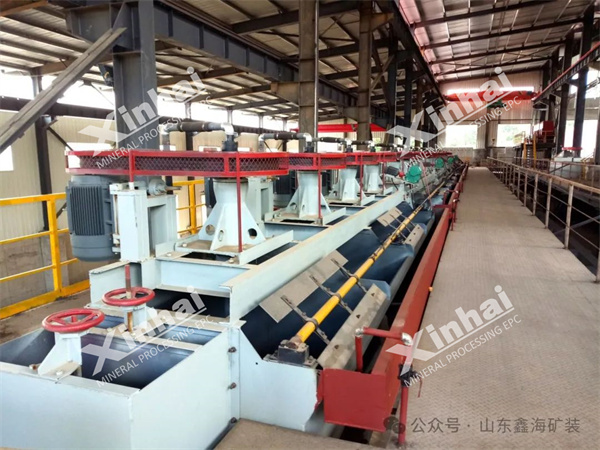There are many types of phosphate ores. Physical and chemical methods such as crushing, grinding, flotation, gravity separation, and magnetic separation are needed to remove gangue minerals and enrich and recover phosphorus. However, different types of phosphate ores have different compositions and different beneficiation processes. This article introduces the beneficiation processes of different types of phosphate ores.
The main components of apatite are CaO (calcium oxide) of about 55.38%, P2O3 (tricalcium phosphate) of about 42.06%, F (fluorine) of about 1.25%, Cl (chlorine) of about 2.33%, H2O (water) of about 0.56%, and apatite may also contain trace amounts of rare earth elements such as Ce (cerium), U (uranium), and Th (thorium). Apatite can be processed by flotation, magnetic separation, roasting and other methods, but a single beneficiation process is difficult to achieve the ideal beneficiation effect. Usually, a combined beneficiation process is used to complete the enrichment of phosphorus. Common combined beneficiation processes include the following:
(1) Flotation-magnetic separation combined process: mainly used for phosphate rock containing magnetic minerals such as iron and titanium.
(2) Grinding-classification-flotation process: used to process phosphate rock with light weathering or no weathering, i.e., less clay.
(3) Stage grinding-stage separation process: used to process phosphate rock with both collophosphite and apatite.
(4) Scrubbing-desludging-flotation process: used to process phosphate rock with severe weathering and high clay content.
(5) Roasting-digestion-classification process: used to process sedimentary calcium phosphate with hard ore and high carbonate minerals (dolomite and calcite).

Collophanite is a phosphate-based aggregate containing a small amount of Si, Al, Fe and other elements. Its main components are phosphate minerals, including apatite, glufosinate, etc., among which apatite is the most common component. Common beneficiation processes for collophanite include flotation, scrubbing and desludging, photoelectric beneficiation, and heavy medium beneficiation. A single beneficiation process cannot achieve good beneficiation results. Here are some common combined beneficiation processes:
(1) Scrubbing and desludging-positive and negative flotation combined process: For medium and low-grade siliceous collophanite, scrubbing and desludging pretreatment is used to remove fine mud and impurities in the ore, and then positive and negative flotation processes are used to further separate phosphate minerals and gangue minerals.
(2) Heavy medium beneficiation and positive and negative flotation combined process: This process combines the advantages of heavy medium beneficiation and positive and negative flotation, and is suitable for pre-selection of coarse particles of phosphate ore, improving the recovery rate of phosphate minerals and the quality of concentrate.
(3) Combined process of photoelectric separation and heavy medium separation: This is a combined process that combines photoelectric separation and heavy medium separation. After high-pressure water washing, the photoelectric separator is used to select the photoelectric concentrate, and then the photoelectric tailings are further crushed and screened.
(4) Combined process of stage grinding-multi-stage reverse flotation-magnetic separation: This process is suitable for difficult-to-separate low-grade siliceous calcium phosphate ore. Through stage grinding and multi-stage reverse flotation, combined with magnetic separation, qualified phosphate concentrate can be obtained.
(5) Phosphate ore magnetic-flotation combined separation method and process: This process removes magnetic impurities in phosphate ore through magnetic separation, and then further improves the quality of phosphate concentrate through flotation.
The main component of phosphotyrite is iron phosphate. The gangue minerals associated with phosphotyrite include quartz, mica, etc., and may also include hematite, magnetite, siderite, etc. Common beneficiation processes for phosphotyrite are:
(1) Strong magnetic separation and tailings discarding-double reverse flotation dephosphorization and desiliconization: This is a beneficiation process for high-phosphorus iron ore. Through strong magnetic separation tailings discarding pretreatment, combined with double reverse flotation dephosphorization and desiliconization, the grade of iron concentrate can be effectively improved and the phosphorus content can be reduced.
(2) Stage grinding-weak magnetic separation-reverse flotation dephosphorization and desiliconization: It is suitable for difficult-to-select high-phosphorus silicon oolitic iron ore. Stage grinding is used to improve the mineral dissociation degree, and then weak magnetic separation and reverse flotation are used to remove phosphorus and silicon to obtain higher-grade iron concentrate.
(3) Scrubbing desludging-positive and negative flotation combined process: It is suitable for medium and low-grade siliceous colloidal phosphate. Scrubbing desludging pretreatment is used to remove fine mud and impurities in the ore, and then positive and negative flotation processes are used to further separate phosphate minerals and gangue minerals.
(4) Combined process of heavy medium beneficiation and direct and reverse flotation: This process combines the advantages of heavy medium beneficiation and direct and reverse flotation, and is suitable for pre-selection of coarse particles of phosphate ore, improving the recovery rate of phosphate minerals and the quality of concentrate.
(5) Flotation, scrubbing and desludging, roasting-digestion, heavy medium beneficiation and combined beneficiation process: These are the dominant methods in phosphate beneficiation. Combined beneficiation process occupies an important position in phosphate beneficiation because it can simplify the process and reduce energy consumption and drug consumption.